Analysis of Business Structures, Finance Options, and UK Sectors
VerifiedAdded on 2022/11/24
|12
|3980
|119
Report
AI Summary
This report provides a comprehensive overview of business structures suitable for startups, including sole proprietorships, partnerships, corporations, and limited liability corporations, detailing their advantages and disadvantages. It then delves into three key sources of startup finance: bank loans, venture capital, and incubators, outlining their benefits and drawbacks. The report further identifies and explains the primary, secondary, and tertiary sectors within the UK economy, highlighting their differences and significance to the nation's growth. Finally, it examines the concept of Human Resource policies, focusing on equality and diversity, and health and safety policies, emphasizing their importance in the workplace. The report aims to equip entrepreneurs with the knowledge needed to make informed decisions regarding business structure, financing, and operational strategies within the UK economic context. This valuable resource is available for students on Desklib, offering past papers and solved assignments.
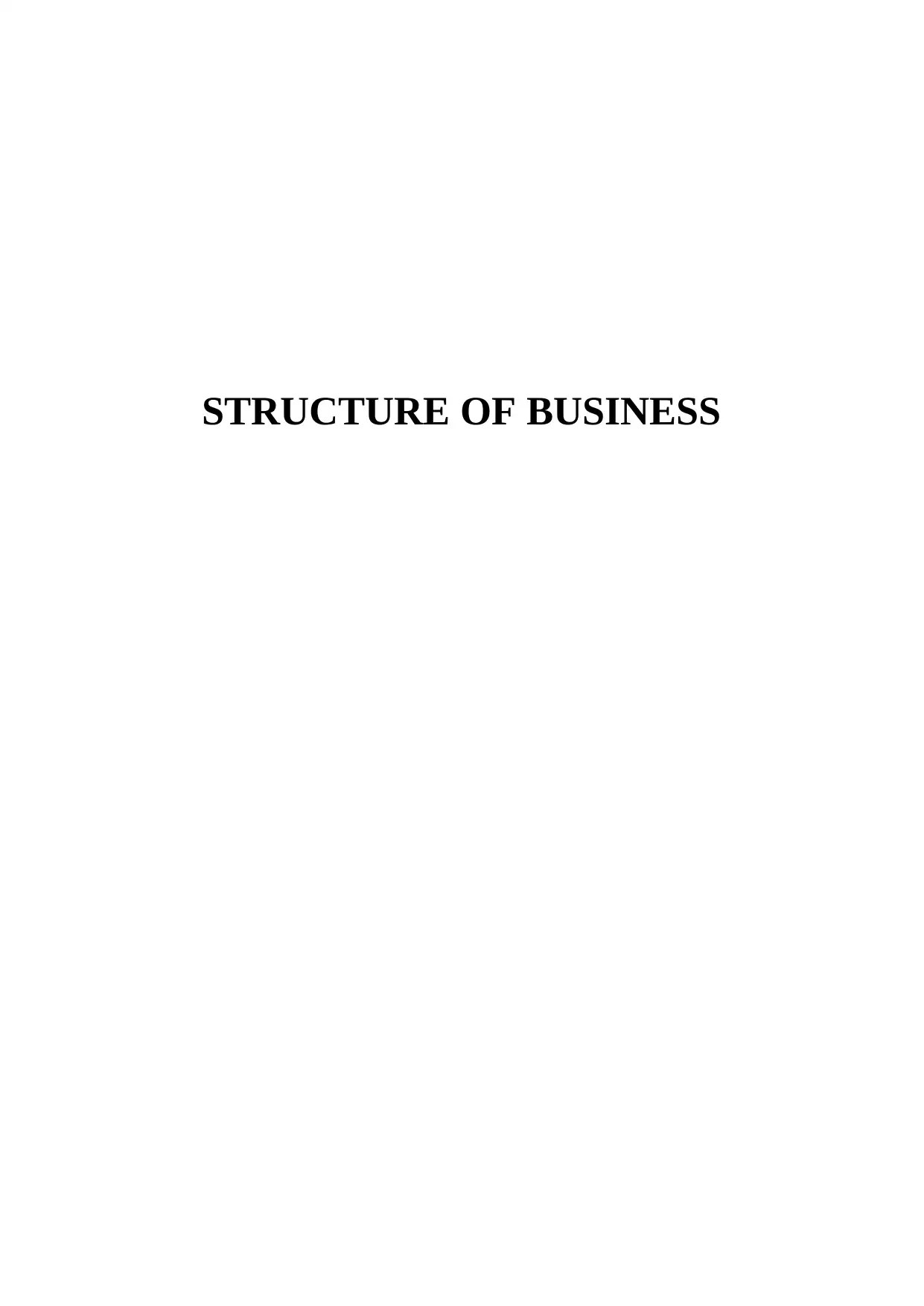
STRUCTURE OF BUSINESS
Paraphrase This Document
Need a fresh take? Get an instant paraphrase of this document with our AI Paraphraser
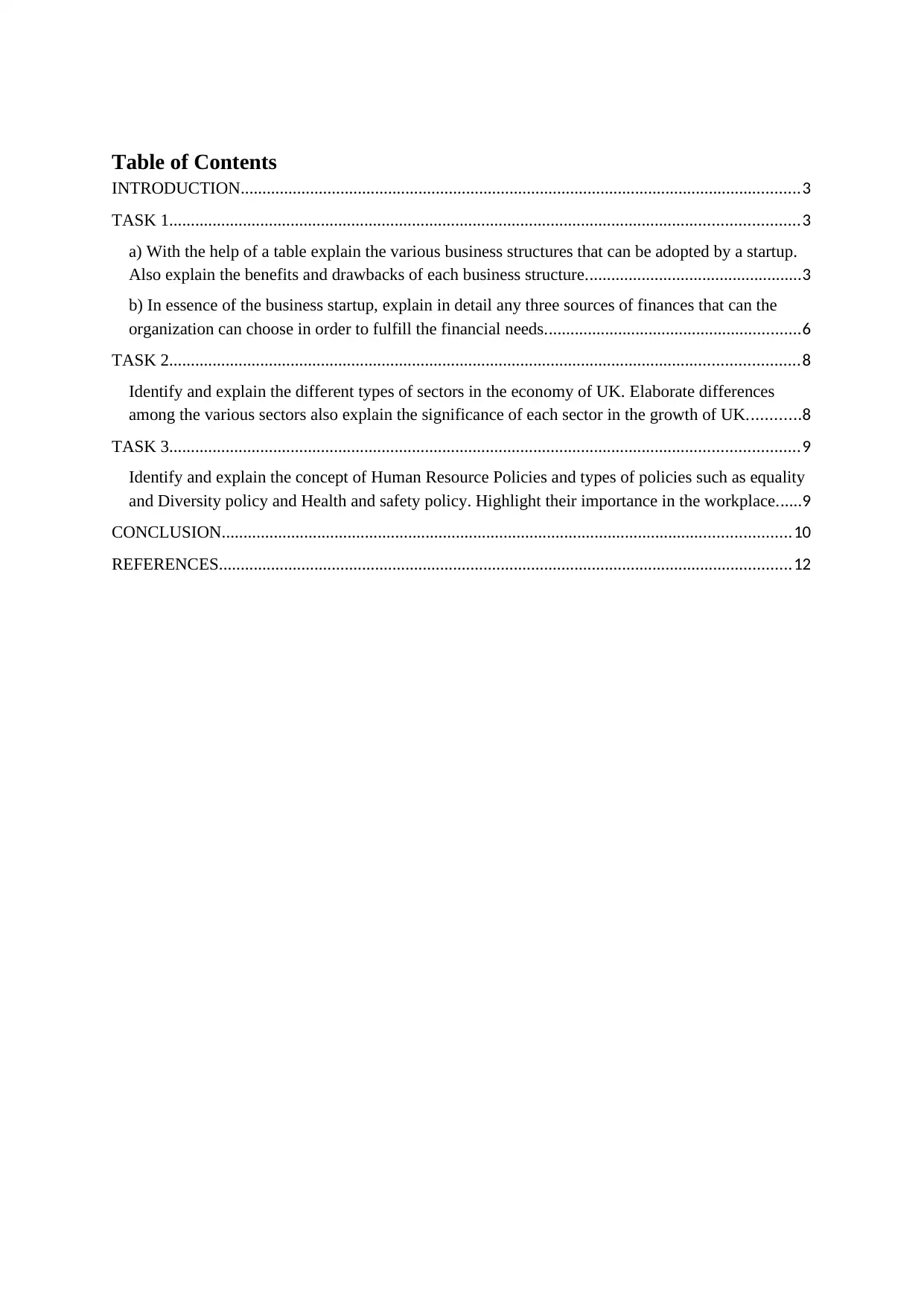
Table of Contents
INTRODUCTION.................................................................................................................................3
TASK 1.................................................................................................................................................3
a) With the help of a table explain the various business structures that can be adopted by a startup.
Also explain the benefits and drawbacks of each business structure..................................................3
b) In essence of the business startup, explain in detail any three sources of finances that can the
organization can choose in order to fulfill the financial needs...........................................................6
TASK 2.................................................................................................................................................8
Identify and explain the different types of sectors in the economy of UK. Elaborate differences
among the various sectors also explain the significance of each sector in the growth of UK............8
TASK 3.................................................................................................................................................9
Identify and explain the concept of Human Resource Policies and types of policies such as equality
and Diversity policy and Health and safety policy. Highlight their importance in the workplace......9
CONCLUSION...................................................................................................................................10
REFERENCES....................................................................................................................................12
INTRODUCTION.................................................................................................................................3
TASK 1.................................................................................................................................................3
a) With the help of a table explain the various business structures that can be adopted by a startup.
Also explain the benefits and drawbacks of each business structure..................................................3
b) In essence of the business startup, explain in detail any three sources of finances that can the
organization can choose in order to fulfill the financial needs...........................................................6
TASK 2.................................................................................................................................................8
Identify and explain the different types of sectors in the economy of UK. Elaborate differences
among the various sectors also explain the significance of each sector in the growth of UK............8
TASK 3.................................................................................................................................................9
Identify and explain the concept of Human Resource Policies and types of policies such as equality
and Diversity policy and Health and safety policy. Highlight their importance in the workplace......9
CONCLUSION...................................................................................................................................10
REFERENCES....................................................................................................................................12
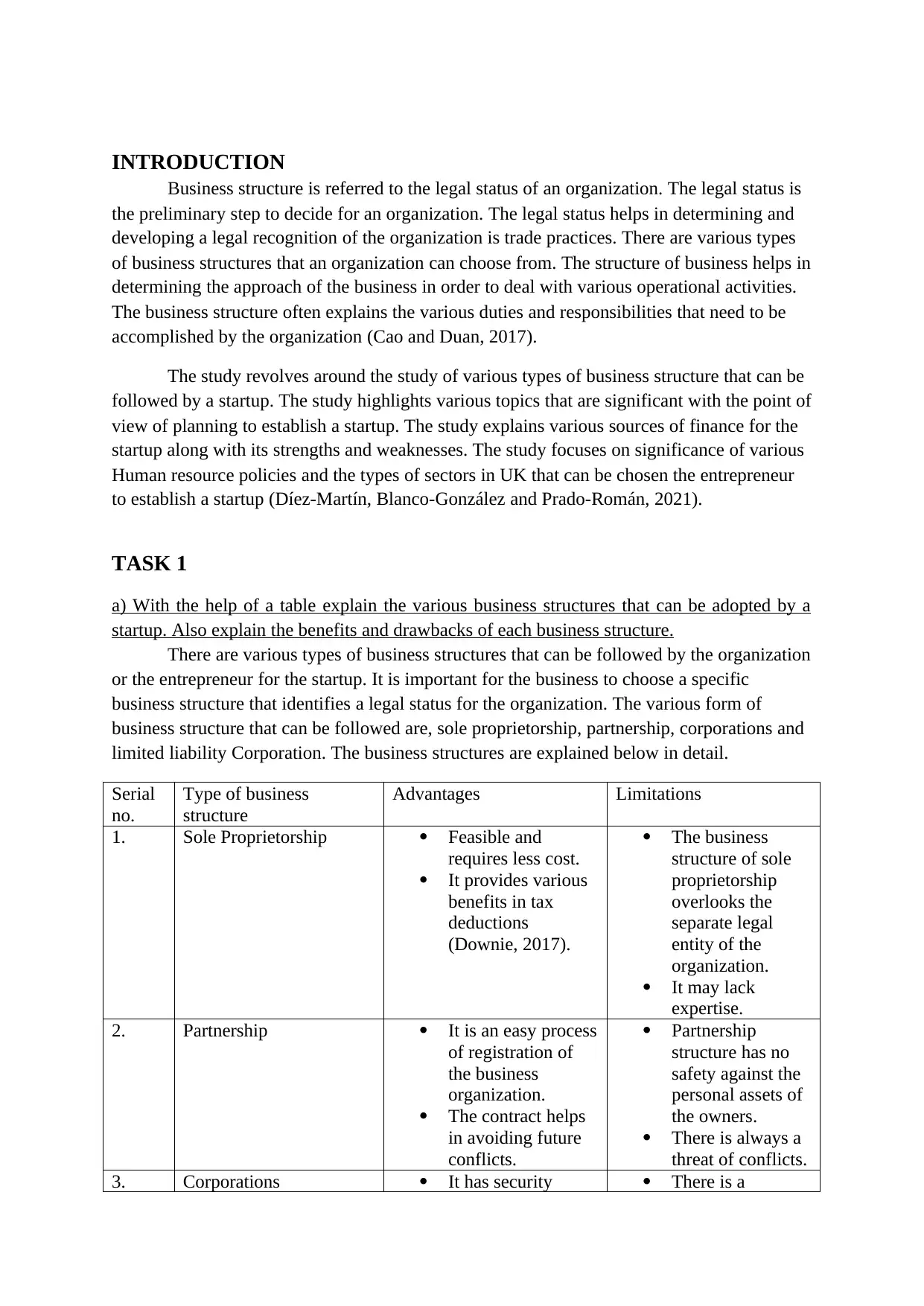
INTRODUCTION
Business structure is referred to the legal status of an organization. The legal status is
the preliminary step to decide for an organization. The legal status helps in determining and
developing a legal recognition of the organization is trade practices. There are various types
of business structures that an organization can choose from. The structure of business helps in
determining the approach of the business in order to deal with various operational activities.
The business structure often explains the various duties and responsibilities that need to be
accomplished by the organization (Cao and Duan, 2017).
The study revolves around the study of various types of business structure that can be
followed by a startup. The study highlights various topics that are significant with the point of
view of planning to establish a startup. The study explains various sources of finance for the
startup along with its strengths and weaknesses. The study focuses on significance of various
Human resource policies and the types of sectors in UK that can be chosen the entrepreneur
to establish a startup (Díez-Martín, Blanco-González and Prado-Román, 2021).
TASK 1
a) With the help of a table explain the various business structures that can be adopted by a
startup. Also explain the benefits and drawbacks of each business structure.
There are various types of business structures that can be followed by the organization
or the entrepreneur for the startup. It is important for the business to choose a specific
business structure that identifies a legal status for the organization. The various form of
business structure that can be followed are, sole proprietorship, partnership, corporations and
limited liability Corporation. The business structures are explained below in detail.
Serial
no.
Type of business
structure
Advantages Limitations
1. Sole Proprietorship Feasible and
requires less cost.
It provides various
benefits in tax
deductions
(Downie, 2017).
The business
structure of sole
proprietorship
overlooks the
separate legal
entity of the
organization.
It may lack
expertise.
2. Partnership It is an easy process
of registration of
the business
organization.
The contract helps
in avoiding future
conflicts.
Partnership
structure has no
safety against the
personal assets of
the owners.
There is always a
threat of conflicts.
3. Corporations It has security There is a
Business structure is referred to the legal status of an organization. The legal status is
the preliminary step to decide for an organization. The legal status helps in determining and
developing a legal recognition of the organization is trade practices. There are various types
of business structures that an organization can choose from. The structure of business helps in
determining the approach of the business in order to deal with various operational activities.
The business structure often explains the various duties and responsibilities that need to be
accomplished by the organization (Cao and Duan, 2017).
The study revolves around the study of various types of business structure that can be
followed by a startup. The study highlights various topics that are significant with the point of
view of planning to establish a startup. The study explains various sources of finance for the
startup along with its strengths and weaknesses. The study focuses on significance of various
Human resource policies and the types of sectors in UK that can be chosen the entrepreneur
to establish a startup (Díez-Martín, Blanco-González and Prado-Román, 2021).
TASK 1
a) With the help of a table explain the various business structures that can be adopted by a
startup. Also explain the benefits and drawbacks of each business structure.
There are various types of business structures that can be followed by the organization
or the entrepreneur for the startup. It is important for the business to choose a specific
business structure that identifies a legal status for the organization. The various form of
business structure that can be followed are, sole proprietorship, partnership, corporations and
limited liability Corporation. The business structures are explained below in detail.
Serial
no.
Type of business
structure
Advantages Limitations
1. Sole Proprietorship Feasible and
requires less cost.
It provides various
benefits in tax
deductions
(Downie, 2017).
The business
structure of sole
proprietorship
overlooks the
separate legal
entity of the
organization.
It may lack
expertise.
2. Partnership It is an easy process
of registration of
the business
organization.
The contract helps
in avoiding future
conflicts.
Partnership
structure has no
safety against the
personal assets of
the owners.
There is always a
threat of conflicts.
3. Corporations It has security There is a
⊘ This is a preview!⊘
Do you want full access?
Subscribe today to unlock all pages.

Trusted by 1+ million students worldwide
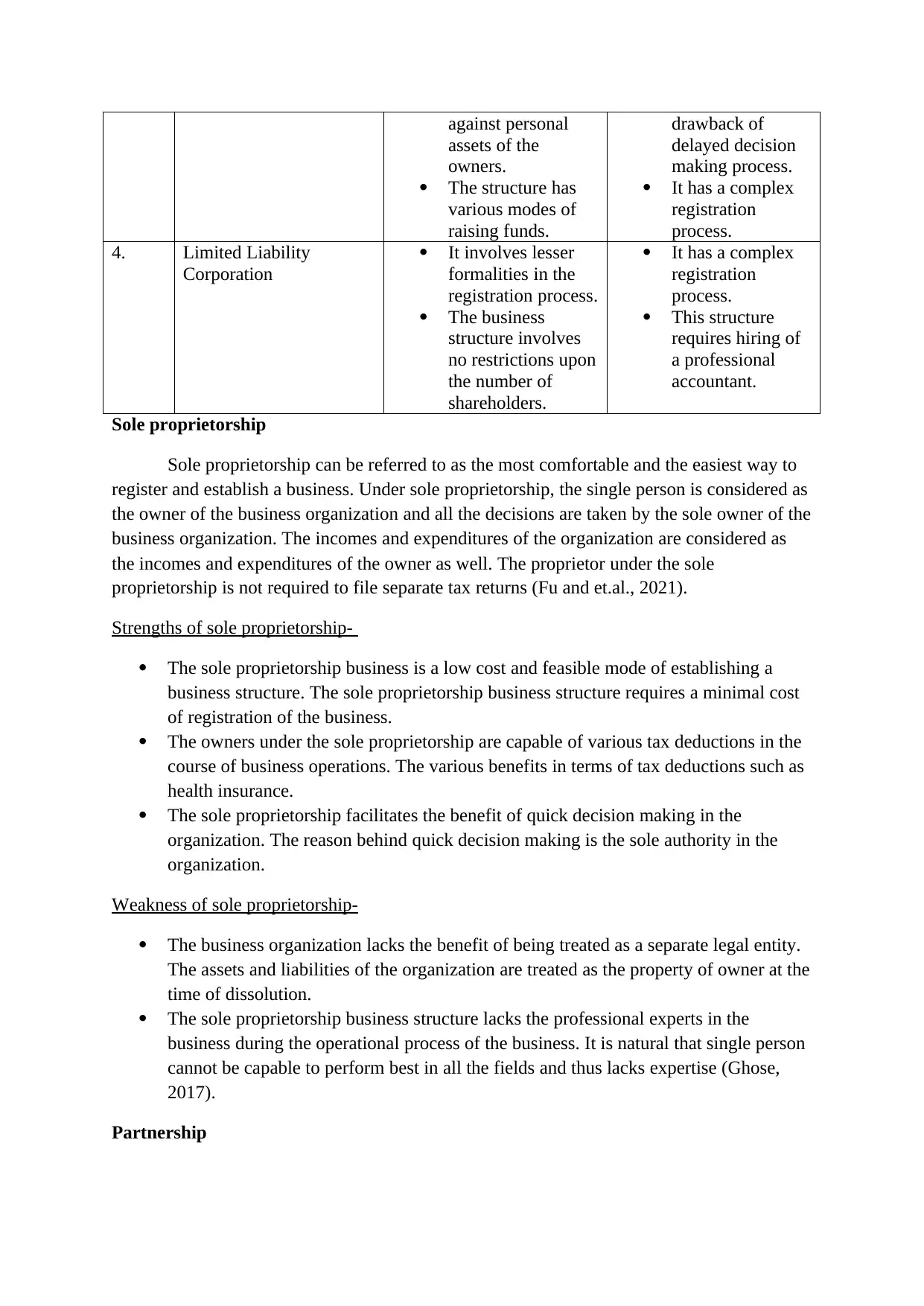
against personal
assets of the
owners.
The structure has
various modes of
raising funds.
drawback of
delayed decision
making process.
It has a complex
registration
process.
4. Limited Liability
Corporation
It involves lesser
formalities in the
registration process.
The business
structure involves
no restrictions upon
the number of
shareholders.
It has a complex
registration
process.
This structure
requires hiring of
a professional
accountant.
Sole proprietorship
Sole proprietorship can be referred to as the most comfortable and the easiest way to
register and establish a business. Under sole proprietorship, the single person is considered as
the owner of the business organization and all the decisions are taken by the sole owner of the
business organization. The incomes and expenditures of the organization are considered as
the incomes and expenditures of the owner as well. The proprietor under the sole
proprietorship is not required to file separate tax returns (Fu and et.al., 2021).
Strengths of sole proprietorship-
The sole proprietorship business is a low cost and feasible mode of establishing a
business structure. The sole proprietorship business structure requires a minimal cost
of registration of the business.
The owners under the sole proprietorship are capable of various tax deductions in the
course of business operations. The various benefits in terms of tax deductions such as
health insurance.
The sole proprietorship facilitates the benefit of quick decision making in the
organization. The reason behind quick decision making is the sole authority in the
organization.
Weakness of sole proprietorship-
The business organization lacks the benefit of being treated as a separate legal entity.
The assets and liabilities of the organization are treated as the property of owner at the
time of dissolution.
The sole proprietorship business structure lacks the professional experts in the
business during the operational process of the business. It is natural that single person
cannot be capable to perform best in all the fields and thus lacks expertise (Ghose,
2017).
Partnership
assets of the
owners.
The structure has
various modes of
raising funds.
drawback of
delayed decision
making process.
It has a complex
registration
process.
4. Limited Liability
Corporation
It involves lesser
formalities in the
registration process.
The business
structure involves
no restrictions upon
the number of
shareholders.
It has a complex
registration
process.
This structure
requires hiring of
a professional
accountant.
Sole proprietorship
Sole proprietorship can be referred to as the most comfortable and the easiest way to
register and establish a business. Under sole proprietorship, the single person is considered as
the owner of the business organization and all the decisions are taken by the sole owner of the
business organization. The incomes and expenditures of the organization are considered as
the incomes and expenditures of the owner as well. The proprietor under the sole
proprietorship is not required to file separate tax returns (Fu and et.al., 2021).
Strengths of sole proprietorship-
The sole proprietorship business is a low cost and feasible mode of establishing a
business structure. The sole proprietorship business structure requires a minimal cost
of registration of the business.
The owners under the sole proprietorship are capable of various tax deductions in the
course of business operations. The various benefits in terms of tax deductions such as
health insurance.
The sole proprietorship facilitates the benefit of quick decision making in the
organization. The reason behind quick decision making is the sole authority in the
organization.
Weakness of sole proprietorship-
The business organization lacks the benefit of being treated as a separate legal entity.
The assets and liabilities of the organization are treated as the property of owner at the
time of dissolution.
The sole proprietorship business structure lacks the professional experts in the
business during the operational process of the business. It is natural that single person
cannot be capable to perform best in all the fields and thus lacks expertise (Ghose,
2017).
Partnership
Paraphrase This Document
Need a fresh take? Get an instant paraphrase of this document with our AI Paraphraser
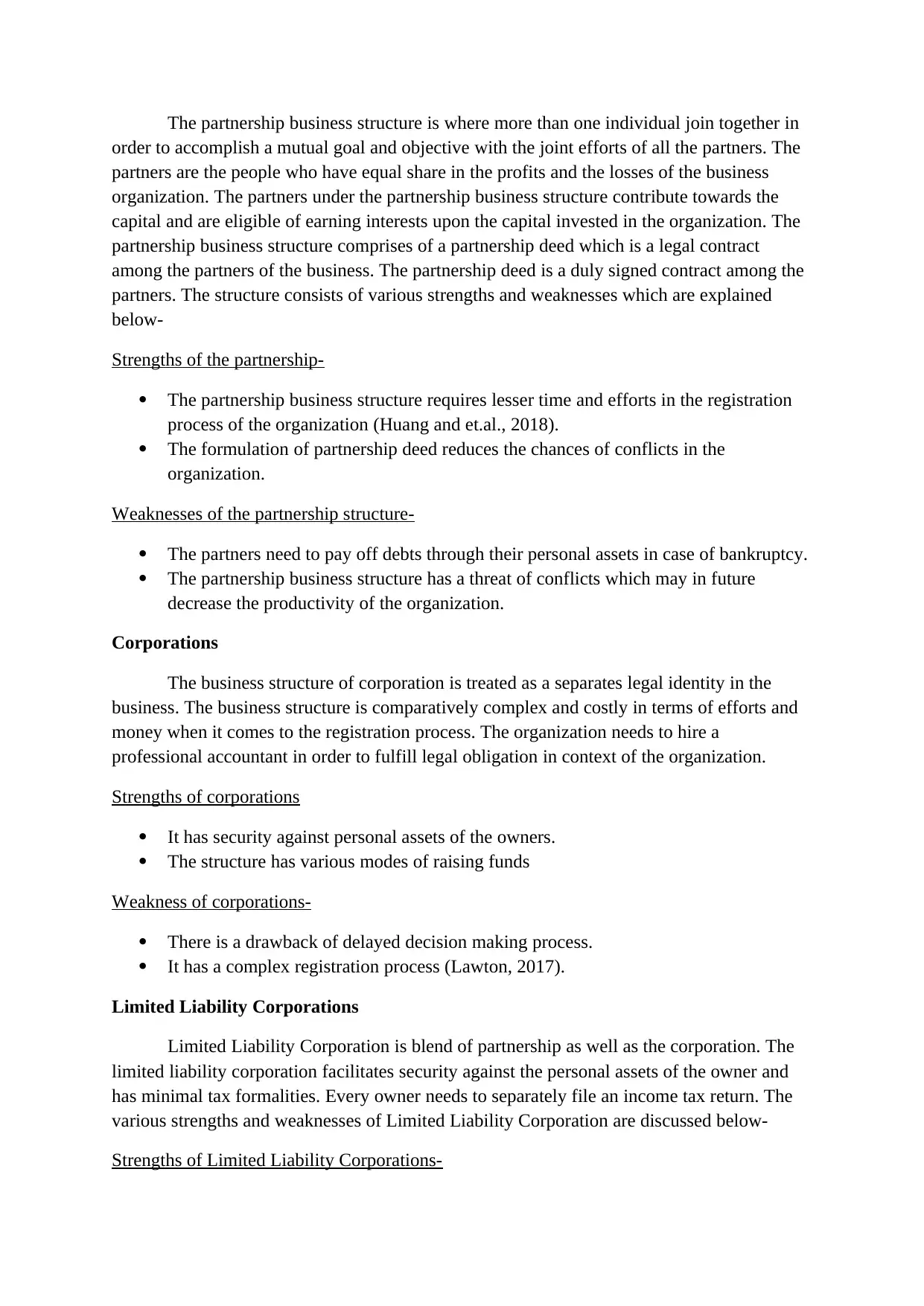
The partnership business structure is where more than one individual join together in
order to accomplish a mutual goal and objective with the joint efforts of all the partners. The
partners are the people who have equal share in the profits and the losses of the business
organization. The partners under the partnership business structure contribute towards the
capital and are eligible of earning interests upon the capital invested in the organization. The
partnership business structure comprises of a partnership deed which is a legal contract
among the partners of the business. The partnership deed is a duly signed contract among the
partners. The structure consists of various strengths and weaknesses which are explained
below-
Strengths of the partnership-
The partnership business structure requires lesser time and efforts in the registration
process of the organization (Huang and et.al., 2018).
The formulation of partnership deed reduces the chances of conflicts in the
organization.
Weaknesses of the partnership structure-
The partners need to pay off debts through their personal assets in case of bankruptcy.
The partnership business structure has a threat of conflicts which may in future
decrease the productivity of the organization.
Corporations
The business structure of corporation is treated as a separates legal identity in the
business. The business structure is comparatively complex and costly in terms of efforts and
money when it comes to the registration process. The organization needs to hire a
professional accountant in order to fulfill legal obligation in context of the organization.
Strengths of corporations
It has security against personal assets of the owners.
The structure has various modes of raising funds
Weakness of corporations-
There is a drawback of delayed decision making process.
It has a complex registration process (Lawton, 2017).
Limited Liability Corporations
Limited Liability Corporation is blend of partnership as well as the corporation. The
limited liability corporation facilitates security against the personal assets of the owner and
has minimal tax formalities. Every owner needs to separately file an income tax return. The
various strengths and weaknesses of Limited Liability Corporation are discussed below-
Strengths of Limited Liability Corporations-
order to accomplish a mutual goal and objective with the joint efforts of all the partners. The
partners are the people who have equal share in the profits and the losses of the business
organization. The partners under the partnership business structure contribute towards the
capital and are eligible of earning interests upon the capital invested in the organization. The
partnership business structure comprises of a partnership deed which is a legal contract
among the partners of the business. The partnership deed is a duly signed contract among the
partners. The structure consists of various strengths and weaknesses which are explained
below-
Strengths of the partnership-
The partnership business structure requires lesser time and efforts in the registration
process of the organization (Huang and et.al., 2018).
The formulation of partnership deed reduces the chances of conflicts in the
organization.
Weaknesses of the partnership structure-
The partners need to pay off debts through their personal assets in case of bankruptcy.
The partnership business structure has a threat of conflicts which may in future
decrease the productivity of the organization.
Corporations
The business structure of corporation is treated as a separates legal identity in the
business. The business structure is comparatively complex and costly in terms of efforts and
money when it comes to the registration process. The organization needs to hire a
professional accountant in order to fulfill legal obligation in context of the organization.
Strengths of corporations
It has security against personal assets of the owners.
The structure has various modes of raising funds
Weakness of corporations-
There is a drawback of delayed decision making process.
It has a complex registration process (Lawton, 2017).
Limited Liability Corporations
Limited Liability Corporation is blend of partnership as well as the corporation. The
limited liability corporation facilitates security against the personal assets of the owner and
has minimal tax formalities. Every owner needs to separately file an income tax return. The
various strengths and weaknesses of Limited Liability Corporation are discussed below-
Strengths of Limited Liability Corporations-
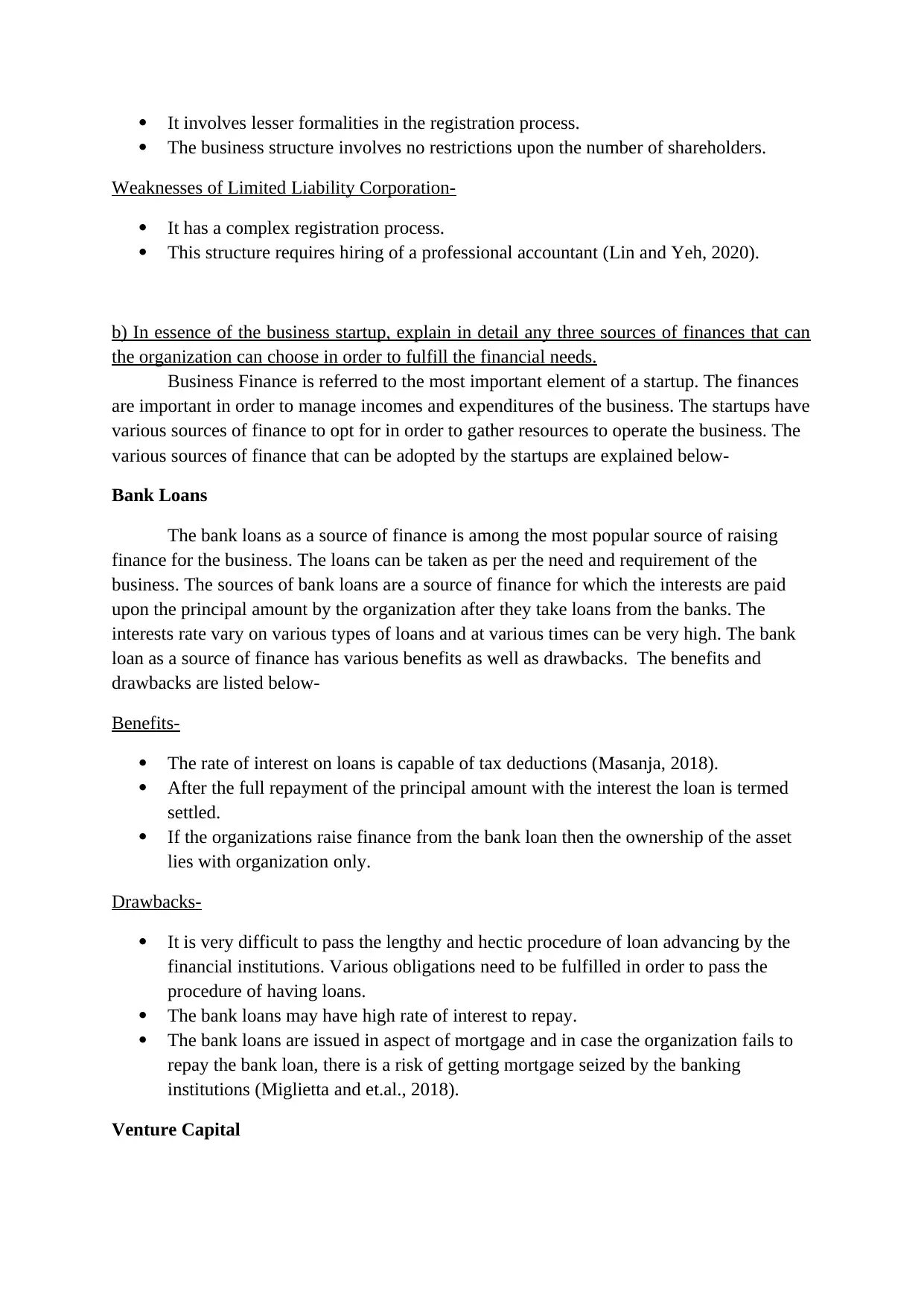
It involves lesser formalities in the registration process.
The business structure involves no restrictions upon the number of shareholders.
Weaknesses of Limited Liability Corporation-
It has a complex registration process.
This structure requires hiring of a professional accountant (Lin and Yeh, 2020).
b) In essence of the business startup, explain in detail any three sources of finances that can
the organization can choose in order to fulfill the financial needs.
Business Finance is referred to the most important element of a startup. The finances
are important in order to manage incomes and expenditures of the business. The startups have
various sources of finance to opt for in order to gather resources to operate the business. The
various sources of finance that can be adopted by the startups are explained below-
Bank Loans
The bank loans as a source of finance is among the most popular source of raising
finance for the business. The loans can be taken as per the need and requirement of the
business. The sources of bank loans are a source of finance for which the interests are paid
upon the principal amount by the organization after they take loans from the banks. The
interests rate vary on various types of loans and at various times can be very high. The bank
loan as a source of finance has various benefits as well as drawbacks. The benefits and
drawbacks are listed below-
Benefits-
The rate of interest on loans is capable of tax deductions (Masanja, 2018).
After the full repayment of the principal amount with the interest the loan is termed
settled.
If the organizations raise finance from the bank loan then the ownership of the asset
lies with organization only.
Drawbacks-
It is very difficult to pass the lengthy and hectic procedure of loan advancing by the
financial institutions. Various obligations need to be fulfilled in order to pass the
procedure of having loans.
The bank loans may have high rate of interest to repay.
The bank loans are issued in aspect of mortgage and in case the organization fails to
repay the bank loan, there is a risk of getting mortgage seized by the banking
institutions (Miglietta and et.al., 2018).
Venture Capital
The business structure involves no restrictions upon the number of shareholders.
Weaknesses of Limited Liability Corporation-
It has a complex registration process.
This structure requires hiring of a professional accountant (Lin and Yeh, 2020).
b) In essence of the business startup, explain in detail any three sources of finances that can
the organization can choose in order to fulfill the financial needs.
Business Finance is referred to the most important element of a startup. The finances
are important in order to manage incomes and expenditures of the business. The startups have
various sources of finance to opt for in order to gather resources to operate the business. The
various sources of finance that can be adopted by the startups are explained below-
Bank Loans
The bank loans as a source of finance is among the most popular source of raising
finance for the business. The loans can be taken as per the need and requirement of the
business. The sources of bank loans are a source of finance for which the interests are paid
upon the principal amount by the organization after they take loans from the banks. The
interests rate vary on various types of loans and at various times can be very high. The bank
loan as a source of finance has various benefits as well as drawbacks. The benefits and
drawbacks are listed below-
Benefits-
The rate of interest on loans is capable of tax deductions (Masanja, 2018).
After the full repayment of the principal amount with the interest the loan is termed
settled.
If the organizations raise finance from the bank loan then the ownership of the asset
lies with organization only.
Drawbacks-
It is very difficult to pass the lengthy and hectic procedure of loan advancing by the
financial institutions. Various obligations need to be fulfilled in order to pass the
procedure of having loans.
The bank loans may have high rate of interest to repay.
The bank loans are issued in aspect of mortgage and in case the organization fails to
repay the bank loan, there is a risk of getting mortgage seized by the banking
institutions (Miglietta and et.al., 2018).
Venture Capital
⊘ This is a preview!⊘
Do you want full access?
Subscribe today to unlock all pages.

Trusted by 1+ million students worldwide
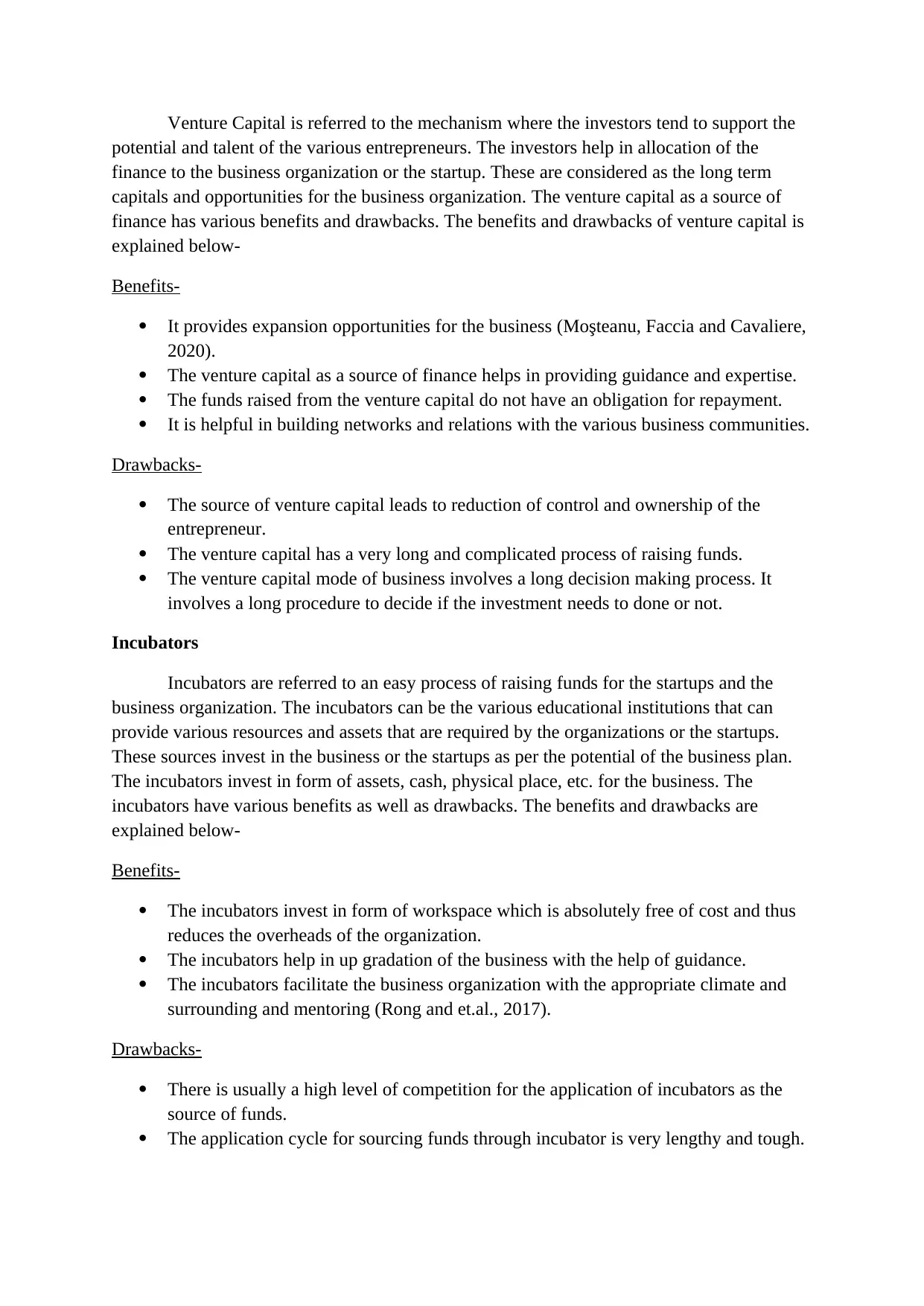
Venture Capital is referred to the mechanism where the investors tend to support the
potential and talent of the various entrepreneurs. The investors help in allocation of the
finance to the business organization or the startup. These are considered as the long term
capitals and opportunities for the business organization. The venture capital as a source of
finance has various benefits and drawbacks. The benefits and drawbacks of venture capital is
explained below-
Benefits-
It provides expansion opportunities for the business (Moşteanu, Faccia and Cavaliere,
2020).
The venture capital as a source of finance helps in providing guidance and expertise.
The funds raised from the venture capital do not have an obligation for repayment.
It is helpful in building networks and relations with the various business communities.
Drawbacks-
The source of venture capital leads to reduction of control and ownership of the
entrepreneur.
The venture capital has a very long and complicated process of raising funds.
The venture capital mode of business involves a long decision making process. It
involves a long procedure to decide if the investment needs to done or not.
Incubators
Incubators are referred to an easy process of raising funds for the startups and the
business organization. The incubators can be the various educational institutions that can
provide various resources and assets that are required by the organizations or the startups.
These sources invest in the business or the startups as per the potential of the business plan.
The incubators invest in form of assets, cash, physical place, etc. for the business. The
incubators have various benefits as well as drawbacks. The benefits and drawbacks are
explained below-
Benefits-
The incubators invest in form of workspace which is absolutely free of cost and thus
reduces the overheads of the organization.
The incubators help in up gradation of the business with the help of guidance.
The incubators facilitate the business organization with the appropriate climate and
surrounding and mentoring (Rong and et.al., 2017).
Drawbacks-
There is usually a high level of competition for the application of incubators as the
source of funds.
The application cycle for sourcing funds through incubator is very lengthy and tough.
potential and talent of the various entrepreneurs. The investors help in allocation of the
finance to the business organization or the startup. These are considered as the long term
capitals and opportunities for the business organization. The venture capital as a source of
finance has various benefits and drawbacks. The benefits and drawbacks of venture capital is
explained below-
Benefits-
It provides expansion opportunities for the business (Moşteanu, Faccia and Cavaliere,
2020).
The venture capital as a source of finance helps in providing guidance and expertise.
The funds raised from the venture capital do not have an obligation for repayment.
It is helpful in building networks and relations with the various business communities.
Drawbacks-
The source of venture capital leads to reduction of control and ownership of the
entrepreneur.
The venture capital has a very long and complicated process of raising funds.
The venture capital mode of business involves a long decision making process. It
involves a long procedure to decide if the investment needs to done or not.
Incubators
Incubators are referred to an easy process of raising funds for the startups and the
business organization. The incubators can be the various educational institutions that can
provide various resources and assets that are required by the organizations or the startups.
These sources invest in the business or the startups as per the potential of the business plan.
The incubators invest in form of assets, cash, physical place, etc. for the business. The
incubators have various benefits as well as drawbacks. The benefits and drawbacks are
explained below-
Benefits-
The incubators invest in form of workspace which is absolutely free of cost and thus
reduces the overheads of the organization.
The incubators help in up gradation of the business with the help of guidance.
The incubators facilitate the business organization with the appropriate climate and
surrounding and mentoring (Rong and et.al., 2017).
Drawbacks-
There is usually a high level of competition for the application of incubators as the
source of funds.
The application cycle for sourcing funds through incubator is very lengthy and tough.
Paraphrase This Document
Need a fresh take? Get an instant paraphrase of this document with our AI Paraphraser
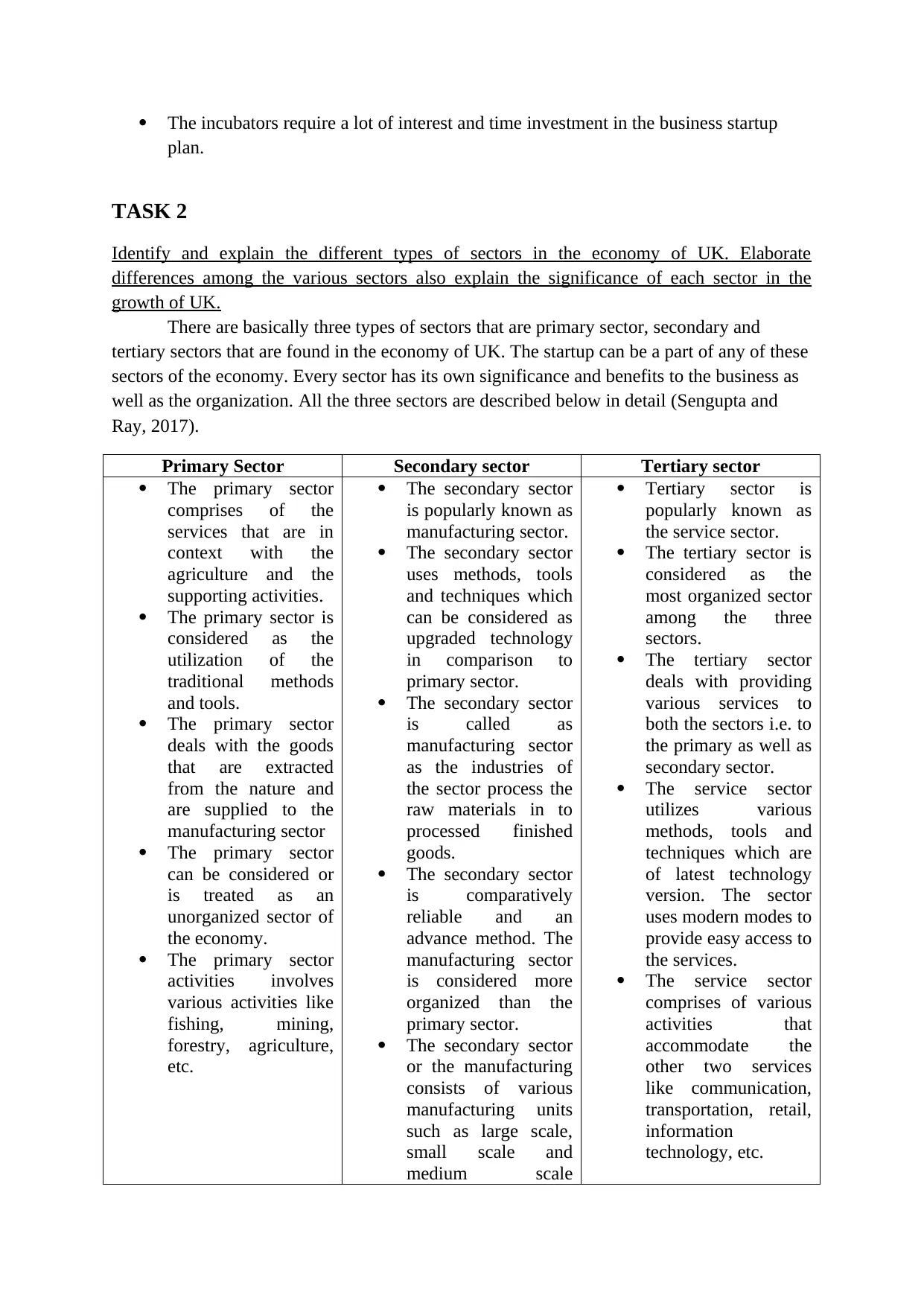
The incubators require a lot of interest and time investment in the business startup
plan.
TASK 2
Identify and explain the different types of sectors in the economy of UK. Elaborate
differences among the various sectors also explain the significance of each sector in the
growth of UK.
There are basically three types of sectors that are primary sector, secondary and
tertiary sectors that are found in the economy of UK. The startup can be a part of any of these
sectors of the economy. Every sector has its own significance and benefits to the business as
well as the organization. All the three sectors are described below in detail (Sengupta and
Ray, 2017).
Primary Sector Secondary sector Tertiary sector
The primary sector
comprises of the
services that are in
context with the
agriculture and the
supporting activities.
The primary sector is
considered as the
utilization of the
traditional methods
and tools.
The primary sector
deals with the goods
that are extracted
from the nature and
are supplied to the
manufacturing sector
The primary sector
can be considered or
is treated as an
unorganized sector of
the economy.
The primary sector
activities involves
various activities like
fishing, mining,
forestry, agriculture,
etc.
The secondary sector
is popularly known as
manufacturing sector.
The secondary sector
uses methods, tools
and techniques which
can be considered as
upgraded technology
in comparison to
primary sector.
The secondary sector
is called as
manufacturing sector
as the industries of
the sector process the
raw materials in to
processed finished
goods.
The secondary sector
is comparatively
reliable and an
advance method. The
manufacturing sector
is considered more
organized than the
primary sector.
The secondary sector
or the manufacturing
consists of various
manufacturing units
such as large scale,
small scale and
medium scale
Tertiary sector is
popularly known as
the service sector.
The tertiary sector is
considered as the
most organized sector
among the three
sectors.
The tertiary sector
deals with providing
various services to
both the sectors i.e. to
the primary as well as
secondary sector.
The service sector
utilizes various
methods, tools and
techniques which are
of latest technology
version. The sector
uses modern modes to
provide easy access to
the services.
The service sector
comprises of various
activities that
accommodate the
other two services
like communication,
transportation, retail,
information
technology, etc.
plan.
TASK 2
Identify and explain the different types of sectors in the economy of UK. Elaborate
differences among the various sectors also explain the significance of each sector in the
growth of UK.
There are basically three types of sectors that are primary sector, secondary and
tertiary sectors that are found in the economy of UK. The startup can be a part of any of these
sectors of the economy. Every sector has its own significance and benefits to the business as
well as the organization. All the three sectors are described below in detail (Sengupta and
Ray, 2017).
Primary Sector Secondary sector Tertiary sector
The primary sector
comprises of the
services that are in
context with the
agriculture and the
supporting activities.
The primary sector is
considered as the
utilization of the
traditional methods
and tools.
The primary sector
deals with the goods
that are extracted
from the nature and
are supplied to the
manufacturing sector
The primary sector
can be considered or
is treated as an
unorganized sector of
the economy.
The primary sector
activities involves
various activities like
fishing, mining,
forestry, agriculture,
etc.
The secondary sector
is popularly known as
manufacturing sector.
The secondary sector
uses methods, tools
and techniques which
can be considered as
upgraded technology
in comparison to
primary sector.
The secondary sector
is called as
manufacturing sector
as the industries of
the sector process the
raw materials in to
processed finished
goods.
The secondary sector
is comparatively
reliable and an
advance method. The
manufacturing sector
is considered more
organized than the
primary sector.
The secondary sector
or the manufacturing
consists of various
manufacturing units
such as large scale,
small scale and
medium scale
Tertiary sector is
popularly known as
the service sector.
The tertiary sector is
considered as the
most organized sector
among the three
sectors.
The tertiary sector
deals with providing
various services to
both the sectors i.e. to
the primary as well as
secondary sector.
The service sector
utilizes various
methods, tools and
techniques which are
of latest technology
version. The sector
uses modern modes to
provide easy access to
the services.
The service sector
comprises of various
activities that
accommodate the
other two services
like communication,
transportation, retail,
information
technology, etc.
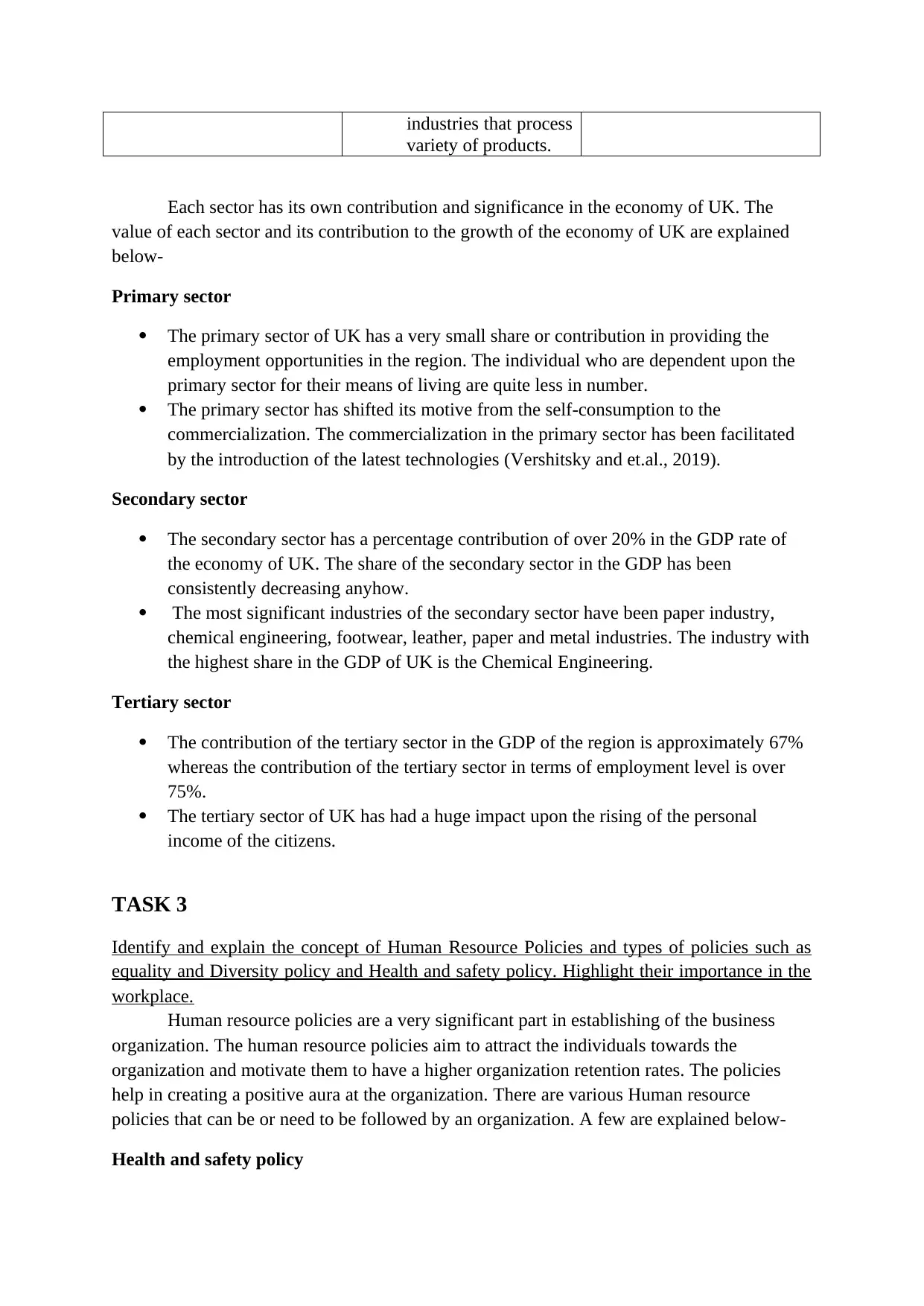
industries that process
variety of products.
Each sector has its own contribution and significance in the economy of UK. The
value of each sector and its contribution to the growth of the economy of UK are explained
below-
Primary sector
The primary sector of UK has a very small share or contribution in providing the
employment opportunities in the region. The individual who are dependent upon the
primary sector for their means of living are quite less in number.
The primary sector has shifted its motive from the self-consumption to the
commercialization. The commercialization in the primary sector has been facilitated
by the introduction of the latest technologies (Vershitsky and et.al., 2019).
Secondary sector
The secondary sector has a percentage contribution of over 20% in the GDP rate of
the economy of UK. The share of the secondary sector in the GDP has been
consistently decreasing anyhow.
The most significant industries of the secondary sector have been paper industry,
chemical engineering, footwear, leather, paper and metal industries. The industry with
the highest share in the GDP of UK is the Chemical Engineering.
Tertiary sector
The contribution of the tertiary sector in the GDP of the region is approximately 67%
whereas the contribution of the tertiary sector in terms of employment level is over
75%.
The tertiary sector of UK has had a huge impact upon the rising of the personal
income of the citizens.
TASK 3
Identify and explain the concept of Human Resource Policies and types of policies such as
equality and Diversity policy and Health and safety policy. Highlight their importance in the
workplace.
Human resource policies are a very significant part in establishing of the business
organization. The human resource policies aim to attract the individuals towards the
organization and motivate them to have a higher organization retention rates. The policies
help in creating a positive aura at the organization. There are various Human resource
policies that can be or need to be followed by an organization. A few are explained below-
Health and safety policy
variety of products.
Each sector has its own contribution and significance in the economy of UK. The
value of each sector and its contribution to the growth of the economy of UK are explained
below-
Primary sector
The primary sector of UK has a very small share or contribution in providing the
employment opportunities in the region. The individual who are dependent upon the
primary sector for their means of living are quite less in number.
The primary sector has shifted its motive from the self-consumption to the
commercialization. The commercialization in the primary sector has been facilitated
by the introduction of the latest technologies (Vershitsky and et.al., 2019).
Secondary sector
The secondary sector has a percentage contribution of over 20% in the GDP rate of
the economy of UK. The share of the secondary sector in the GDP has been
consistently decreasing anyhow.
The most significant industries of the secondary sector have been paper industry,
chemical engineering, footwear, leather, paper and metal industries. The industry with
the highest share in the GDP of UK is the Chemical Engineering.
Tertiary sector
The contribution of the tertiary sector in the GDP of the region is approximately 67%
whereas the contribution of the tertiary sector in terms of employment level is over
75%.
The tertiary sector of UK has had a huge impact upon the rising of the personal
income of the citizens.
TASK 3
Identify and explain the concept of Human Resource Policies and types of policies such as
equality and Diversity policy and Health and safety policy. Highlight their importance in the
workplace.
Human resource policies are a very significant part in establishing of the business
organization. The human resource policies aim to attract the individuals towards the
organization and motivate them to have a higher organization retention rates. The policies
help in creating a positive aura at the organization. There are various Human resource
policies that can be or need to be followed by an organization. A few are explained below-
Health and safety policy
⊘ This is a preview!⊘
Do you want full access?
Subscribe today to unlock all pages.

Trusted by 1+ million students worldwide
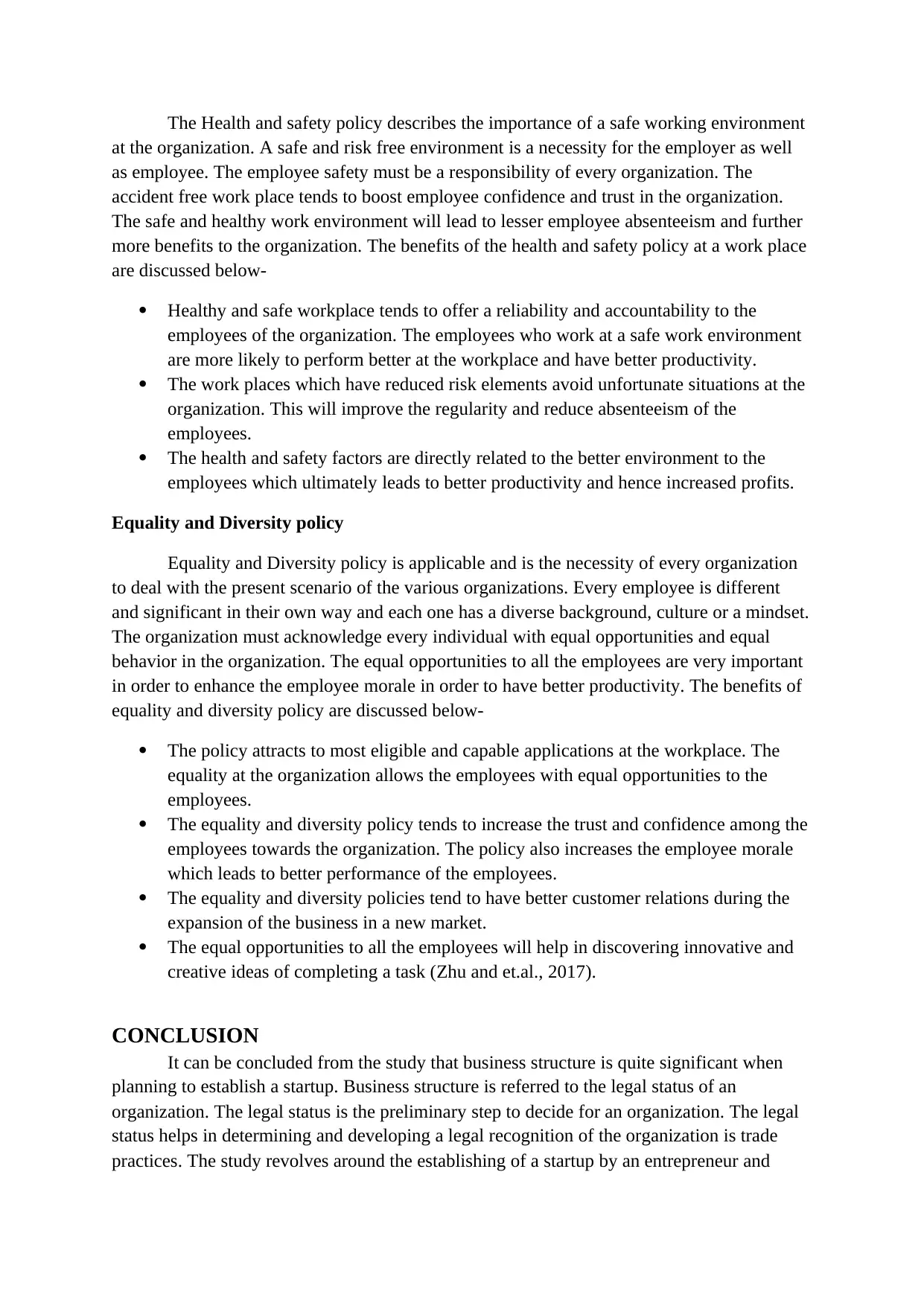
The Health and safety policy describes the importance of a safe working environment
at the organization. A safe and risk free environment is a necessity for the employer as well
as employee. The employee safety must be a responsibility of every organization. The
accident free work place tends to boost employee confidence and trust in the organization.
The safe and healthy work environment will lead to lesser employee absenteeism and further
more benefits to the organization. The benefits of the health and safety policy at a work place
are discussed below-
Healthy and safe workplace tends to offer a reliability and accountability to the
employees of the organization. The employees who work at a safe work environment
are more likely to perform better at the workplace and have better productivity.
The work places which have reduced risk elements avoid unfortunate situations at the
organization. This will improve the regularity and reduce absenteeism of the
employees.
The health and safety factors are directly related to the better environment to the
employees which ultimately leads to better productivity and hence increased profits.
Equality and Diversity policy
Equality and Diversity policy is applicable and is the necessity of every organization
to deal with the present scenario of the various organizations. Every employee is different
and significant in their own way and each one has a diverse background, culture or a mindset.
The organization must acknowledge every individual with equal opportunities and equal
behavior in the organization. The equal opportunities to all the employees are very important
in order to enhance the employee morale in order to have better productivity. The benefits of
equality and diversity policy are discussed below-
The policy attracts to most eligible and capable applications at the workplace. The
equality at the organization allows the employees with equal opportunities to the
employees.
The equality and diversity policy tends to increase the trust and confidence among the
employees towards the organization. The policy also increases the employee morale
which leads to better performance of the employees.
The equality and diversity policies tend to have better customer relations during the
expansion of the business in a new market.
The equal opportunities to all the employees will help in discovering innovative and
creative ideas of completing a task (Zhu and et.al., 2017).
CONCLUSION
It can be concluded from the study that business structure is quite significant when
planning to establish a startup. Business structure is referred to the legal status of an
organization. The legal status is the preliminary step to decide for an organization. The legal
status helps in determining and developing a legal recognition of the organization is trade
practices. The study revolves around the establishing of a startup by an entrepreneur and
at the organization. A safe and risk free environment is a necessity for the employer as well
as employee. The employee safety must be a responsibility of every organization. The
accident free work place tends to boost employee confidence and trust in the organization.
The safe and healthy work environment will lead to lesser employee absenteeism and further
more benefits to the organization. The benefits of the health and safety policy at a work place
are discussed below-
Healthy and safe workplace tends to offer a reliability and accountability to the
employees of the organization. The employees who work at a safe work environment
are more likely to perform better at the workplace and have better productivity.
The work places which have reduced risk elements avoid unfortunate situations at the
organization. This will improve the regularity and reduce absenteeism of the
employees.
The health and safety factors are directly related to the better environment to the
employees which ultimately leads to better productivity and hence increased profits.
Equality and Diversity policy
Equality and Diversity policy is applicable and is the necessity of every organization
to deal with the present scenario of the various organizations. Every employee is different
and significant in their own way and each one has a diverse background, culture or a mindset.
The organization must acknowledge every individual with equal opportunities and equal
behavior in the organization. The equal opportunities to all the employees are very important
in order to enhance the employee morale in order to have better productivity. The benefits of
equality and diversity policy are discussed below-
The policy attracts to most eligible and capable applications at the workplace. The
equality at the organization allows the employees with equal opportunities to the
employees.
The equality and diversity policy tends to increase the trust and confidence among the
employees towards the organization. The policy also increases the employee morale
which leads to better performance of the employees.
The equality and diversity policies tend to have better customer relations during the
expansion of the business in a new market.
The equal opportunities to all the employees will help in discovering innovative and
creative ideas of completing a task (Zhu and et.al., 2017).
CONCLUSION
It can be concluded from the study that business structure is quite significant when
planning to establish a startup. Business structure is referred to the legal status of an
organization. The legal status is the preliminary step to decide for an organization. The legal
status helps in determining and developing a legal recognition of the organization is trade
practices. The study revolves around the establishing of a startup by an entrepreneur and
Paraphrase This Document
Need a fresh take? Get an instant paraphrase of this document with our AI Paraphraser
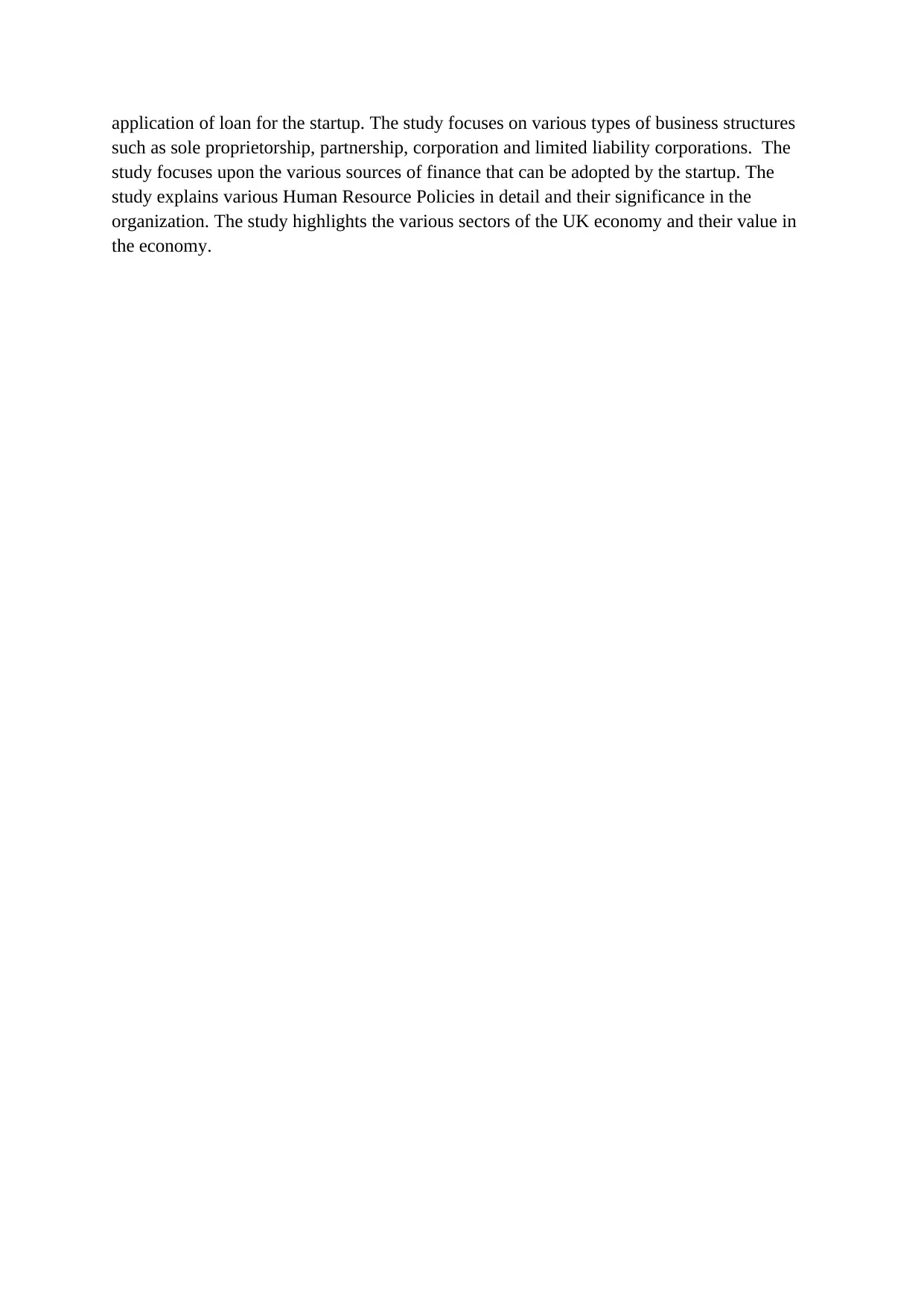
application of loan for the startup. The study focuses on various types of business structures
such as sole proprietorship, partnership, corporation and limited liability corporations. The
study focuses upon the various sources of finance that can be adopted by the startup. The
study explains various Human Resource Policies in detail and their significance in the
organization. The study highlights the various sectors of the UK economy and their value in
the economy.
such as sole proprietorship, partnership, corporation and limited liability corporations. The
study focuses upon the various sources of finance that can be adopted by the startup. The
study explains various Human Resource Policies in detail and their significance in the
organization. The study highlights the various sectors of the UK economy and their value in
the economy.
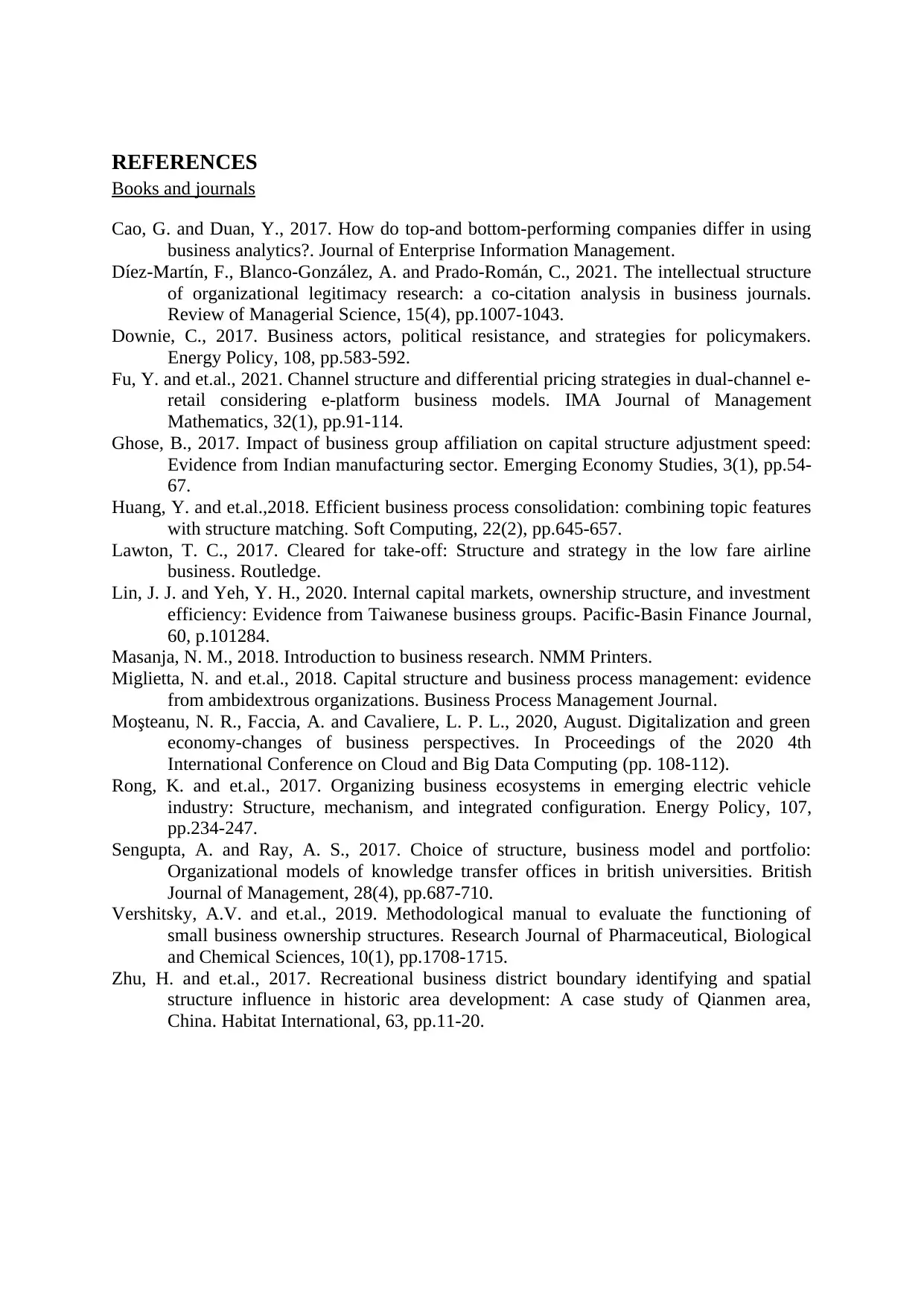
REFERENCES
Books and journals
Cao, G. and Duan, Y., 2017. How do top-and bottom-performing companies differ in using
business analytics?. Journal of Enterprise Information Management.
Díez-Martín, F., Blanco-González, A. and Prado-Román, C., 2021. The intellectual structure
of organizational legitimacy research: a co-citation analysis in business journals.
Review of Managerial Science, 15(4), pp.1007-1043.
Downie, C., 2017. Business actors, political resistance, and strategies for policymakers.
Energy Policy, 108, pp.583-592.
Fu, Y. and et.al., 2021. Channel structure and differential pricing strategies in dual-channel e-
retail considering e-platform business models. IMA Journal of Management
Mathematics, 32(1), pp.91-114.
Ghose, B., 2017. Impact of business group affiliation on capital structure adjustment speed:
Evidence from Indian manufacturing sector. Emerging Economy Studies, 3(1), pp.54-
67.
Huang, Y. and et.al.,2018. Efficient business process consolidation: combining topic features
with structure matching. Soft Computing, 22(2), pp.645-657.
Lawton, T. C., 2017. Cleared for take-off: Structure and strategy in the low fare airline
business. Routledge.
Lin, J. J. and Yeh, Y. H., 2020. Internal capital markets, ownership structure, and investment
efficiency: Evidence from Taiwanese business groups. Pacific-Basin Finance Journal,
60, p.101284.
Masanja, N. M., 2018. Introduction to business research. NMM Printers.
Miglietta, N. and et.al., 2018. Capital structure and business process management: evidence
from ambidextrous organizations. Business Process Management Journal.
Moşteanu, N. R., Faccia, A. and Cavaliere, L. P. L., 2020, August. Digitalization and green
economy-changes of business perspectives. In Proceedings of the 2020 4th
International Conference on Cloud and Big Data Computing (pp. 108-112).
Rong, K. and et.al., 2017. Organizing business ecosystems in emerging electric vehicle
industry: Structure, mechanism, and integrated configuration. Energy Policy, 107,
pp.234-247.
Sengupta, A. and Ray, A. S., 2017. Choice of structure, business model and portfolio:
Organizational models of knowledge transfer offices in british universities. British
Journal of Management, 28(4), pp.687-710.
Vershitsky, A.V. and et.al., 2019. Methodological manual to evaluate the functioning of
small business ownership structures. Research Journal of Pharmaceutical, Biological
and Chemical Sciences, 10(1), pp.1708-1715.
Zhu, H. and et.al., 2017. Recreational business district boundary identifying and spatial
structure influence in historic area development: A case study of Qianmen area,
China. Habitat International, 63, pp.11-20.
Books and journals
Cao, G. and Duan, Y., 2017. How do top-and bottom-performing companies differ in using
business analytics?. Journal of Enterprise Information Management.
Díez-Martín, F., Blanco-González, A. and Prado-Román, C., 2021. The intellectual structure
of organizational legitimacy research: a co-citation analysis in business journals.
Review of Managerial Science, 15(4), pp.1007-1043.
Downie, C., 2017. Business actors, political resistance, and strategies for policymakers.
Energy Policy, 108, pp.583-592.
Fu, Y. and et.al., 2021. Channel structure and differential pricing strategies in dual-channel e-
retail considering e-platform business models. IMA Journal of Management
Mathematics, 32(1), pp.91-114.
Ghose, B., 2017. Impact of business group affiliation on capital structure adjustment speed:
Evidence from Indian manufacturing sector. Emerging Economy Studies, 3(1), pp.54-
67.
Huang, Y. and et.al.,2018. Efficient business process consolidation: combining topic features
with structure matching. Soft Computing, 22(2), pp.645-657.
Lawton, T. C., 2017. Cleared for take-off: Structure and strategy in the low fare airline
business. Routledge.
Lin, J. J. and Yeh, Y. H., 2020. Internal capital markets, ownership structure, and investment
efficiency: Evidence from Taiwanese business groups. Pacific-Basin Finance Journal,
60, p.101284.
Masanja, N. M., 2018. Introduction to business research. NMM Printers.
Miglietta, N. and et.al., 2018. Capital structure and business process management: evidence
from ambidextrous organizations. Business Process Management Journal.
Moşteanu, N. R., Faccia, A. and Cavaliere, L. P. L., 2020, August. Digitalization and green
economy-changes of business perspectives. In Proceedings of the 2020 4th
International Conference on Cloud and Big Data Computing (pp. 108-112).
Rong, K. and et.al., 2017. Organizing business ecosystems in emerging electric vehicle
industry: Structure, mechanism, and integrated configuration. Energy Policy, 107,
pp.234-247.
Sengupta, A. and Ray, A. S., 2017. Choice of structure, business model and portfolio:
Organizational models of knowledge transfer offices in british universities. British
Journal of Management, 28(4), pp.687-710.
Vershitsky, A.V. and et.al., 2019. Methodological manual to evaluate the functioning of
small business ownership structures. Research Journal of Pharmaceutical, Biological
and Chemical Sciences, 10(1), pp.1708-1715.
Zhu, H. and et.al., 2017. Recreational business district boundary identifying and spatial
structure influence in historic area development: A case study of Qianmen area,
China. Habitat International, 63, pp.11-20.
⊘ This is a preview!⊘
Do you want full access?
Subscribe today to unlock all pages.

Trusted by 1+ million students worldwide
1 out of 12
Related Documents
Your All-in-One AI-Powered Toolkit for Academic Success.
+13062052269
info@desklib.com
Available 24*7 on WhatsApp / Email
![[object Object]](/_next/static/media/star-bottom.7253800d.svg)
Unlock your academic potential
Copyright © 2020–2025 A2Z Services. All Rights Reserved. Developed and managed by ZUCOL.





